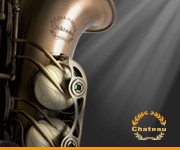 Forgot Username? Forgot Password?
Forgot Username? Forgot Password?
 SELMER's History
SELMER's History
SELMER
In 1844 the French clarinet maker Louis Auguste Buffet collaborated with the celebrated clarinet virtuoso and Paris Conservatory instructor Hyacinthe Eleonore Klosé to create an instrument with seventeen keys and five of Theobald Boehm's brille rings. This new system was not called the "Buffet-Klosé system" as it should have been, but instead it was called the "Boehm-Klosé system" clarinet. In time it would become the standard clarinet of France and the Americas, and the most popular system in England.
A student of Klosé and a renowned clarinetist during his time was Fréderic Selmer. His sons were Henri and Alexandre Selmer, both professional clarinetists. The elder Selmer was painfully aware of the limitations of the instruments available to him. They had intonation problems and didn't sound as well as he imagined that they should sound. He yearned for better quality instruments and succeeded to impress his dreams upon his two sons.
In 1885 Henri Selmer founded H. and A. Selmer & Cie. He abandoned his career as a performer to do full-time research to improve the instrument and its manufacture. Meanwhile his brother Alexandre rose to prominence as a clarinetist in French and American orchestras. Alexandre became principle clarinetist in the New York Philharmonic. While playing with New York he returned to France and brought back with him several of his brother's clarinets and began using them in the orchestra. Other players heard and played them, and the instruments created such a sensation that the Selmer's soon were receiving numerous orders. Alexandre obliged by opening a retail shop in New York City in hopes of satisfying the demand for Selmer-made products.
Alexandre was also actively teaching while in New York, and one of his students was George M. Bundy, a native of Indianapolis. Bundy was fascinated with the Selmer clarinets. After a few years in New York, Alexandre decided to return to France and help his brother with the business, and he left Bundy in charge of the New York store. But Bundy had far greater aspirations. He wanted to set up a Selmer factory in America. With the help of Carl Greenleaf, in 1927 Bundy opened the new American Selmer company in Elkhart. They began to make designated Selmer (USA) instruments and to continue to import Selmer (Paris) products.
Selmer gradually became one of the giants of musical instrument manufacturing by acquiring other companies. In 1958 Selmer bought Harry Pedler and Sons. It is said that the Pedler tooling was used to start Selmer's satellite the Bundy Band Instrument Corporation founded in that year and named in honor of George Bundy who had died in 1951. Initially Bundy was a separate operation from Selmer, but it was merged to its parent in 1965, and the Bundy trademark is used on Selmer's student line instruments.
In 1963 Selmer bought the Buescher Band Instrument Company and infrequently uses the Buescher trademark on some instruments marketed overseas.
In 1963 Selmer purchased the prestigious Vincent Bach Corporation, and in 1965 the factory was moved from Mt. Vernon NY to Elkhart. Bach's know-how aided the development of Bundy brass instruments, and Vincent Bach was retained as a consultant by Selmer until his death in 1976.
In 1968 Selmer bought the Lesher Woodwind Company, a manufacturer of oboes and bassoons. Lesher had been making instruments for Selmer and putting the Selmer trademark on them. After the buyout Selmer dropped the Lesher trademark and used Lesher's tooling.
In 1978 Selmer acquired Glaesel Stringed Instrument Services of Cleveland, Ohio and chose to continue the Cleveland operation as before. n
In 1981 Selmer acquired Ludwig Industries, the world-renowned manufacturer of percussion instruments.
With the exit of C.G. Conn Ltd. from Elkhart in 1972, Selmer became Elkhart's largest manufacturer along with becoming one of the largest music companies in the world. It has managed to supplant Conn as America's leader in the industry.
THE SELMER SAGA
The Selmer story begins in the 18th Century in a peasant family from Loraine. Their wish was to move to the town and the only way, at that time, was to join the army. So, for several generations, the Selmers grew up with the same regiment and when the boys were too young to be soldiers, they joined the regiment's band.
The first of the line Johan Jacobus Zelmer, born around 1770, became drum-major towards the end of the 18th century. Military status opened the doors of education and travel from which benefitted three generations of Selmer military musicians.
Charles-Frederic Selmer (the Z became an S with his father) of the third generation died in 1878, leaving 16 children of whom 5 reached adulthood, 4 with obvious musical talents. Of these, Henri Selmer started a musical career very early and left the conservatory as an accompolished clarinettist in 1880. He joined the Garde republicaine but quickly discovered tha he was little suited to military discipline and soon left for the orchestra of the "Opera Comique'. In reply to his own needs as well as those of his fellow musicians he began making his own reeds. His competence became rapidly evident and his reeds were soon in such a great demand, that he was able to open a small workshop to manufacture reeds and later on mouthpieces, too. These were he small beginnings from which the legend grew. In 1900, encouraged by continuing demand, Henri also undertook adjustment, modifications and repair work which led him rapidly to the conception and manufacture of clarinettes, and soon set himiself up with about 20 companions in a workshop, Place Dancourt, in Paris. His instruments met with universal acclaim.
Henri's othe trump card was his brother Alexandre who followed an important career in America from 1895 to 1910 as solo-clarinettist in three great orchestras: The Boston Symphony Orchestra, The Cincinnati Symphony Orchestra, and finally the New York Philharmonic Orchestra.
Also around 1900, the two brothers opened a retail store in New York (which is the beginning of Selmer USA) and had an agent in London (Mr. Gomez). Selmer instruments, therefore, crossed the Atlantic and won a gold medal at the Saint Louis exhibition. In 1910, Alexandre Selmer returned to France, leaving his place in New York to one of his students: George Bundy. At this time instrument manufacture in Europe was flourishing industry, exporting throughout the world, and Henry Selmer decided to take things a step further, to diversify and industrialize his production, facing competition by other important french manufacturers such as Evett-Shaeffer, Buffet-Crampon, Couesnon and Noblet.
From 1910 to 1920 Henry extended his production to the whole woodwind family of clarinettes, bassoons and oboes, opening a new workshop in Meru and a steam factory in Gaillon. For some years, the Lefevres, Paul, and father, and his two sons Maurice and Henri, had been working for Henri Selmer. At the beginning of the war in 1914, Henri Lefevre was mobilized and left for the front with a saxophone of his own making. The instrument attracted the attention of Henri Selmer for, since its creation by Adolphe Sax, it had changed little and was declining in popularity. The Gaillon factory was too small to complete the transition from clarinette to saxophone, so in 1919 Henri Selmer decided to open a new factory at Mantes where the other saxophone makers, Dolnet and Evette-Shaeffer, were already established. The Lefevres were responsible for production, while Henri Selmer looked after all the management aspects with his brother Alexandre who also tested the clarinettes. Maurice Selmer, Henri's son, began to look after commercial and artistic affairs and some adjustment of instruments.
Maurice and Henri Lefevre, both now sons-in-laws of Henri Selmer, developed and perfected production methods and machine-tools. At the end of 1921, the first Selmer saxophone was born, the model 22, an alto. Continuing the manufacture of clarinettes, reeds and mouthpieces, the Mantes factory was enlarged and in 1928 Henri Selmer took over the Adolphe Sax workshoips (which had previously absorbed Millereaud), thus extending the brass manufacture to trumpets and trombones and lifting Selmer-Paris to the top levels of world production of wind instruments, in particular with the introduction of a new saxophone, the model 28 "Cigar Cutter". Then, in 1933, after a detailed technoligical study of all saxophones on the market, Selmer presented his model 35/36 "Balanced Action" sax, an extremely refined model both mechanically and acoustically. Furthermore, with the rise of jazz, Selmer began working with the guitar Mario Maccaferi. The resulting Selmer-Maccaferi guitars were immortalized by Django Reinhardt even though their production remained limited. Henri Selmer died in July 1941 and was replaced at the head of the firm by his son Maurice who had, for some time, been taking on more and more management responsibilities. Th war years were, of course very difficult, few raw materials, exporting almost impossible, and many other problems. The company was almost put into "hibernation" and temporary activities had to be adopted, even the manufacture of bicycle pumps!
After the war Maurice Selmer revived the firm with a complete range of instruments. Assisted by the momentum brought to jazz by the influx of American troops and the simultaneous development of classical studies of the saxophone, the instrument eveolved rapidly, bringing us to 1954 and the Mark VI model which saw the modification of the position and size of the holes, the key mechanism, and above all the change in position for each hand. The Mark VI remained in the front line for many years, until 1974 when a new model, the Mark VII was presented at the saxophone Congress in Bordeaux, bringing important acoustic improvements. Finally, in 1981, the "Super Action 80" made its appearance and is still the principal model today, when it is more important than ever to produce an instrument as perfect as possible, and this as cheaply as possible in order to remain competitive on the modern market. But Selmer-Paris has always continued to develop its potential.
Until 1960 the mechanism of the production process was the main priority. The soaring raw materials and labor costs combined with the continuing need to increase production made a complete reoganization and industrialization necessary, and labor costs still represent 75-80% of the retail price of an instrument.
After the death of Maurice Selmer in 1961, Henri Lefevre became Director of the company until his accidental death in 1981. He was succeeded by Georges Selmer who is assisted by his brother Jean as Technical Director and new product development menager, and by Jacques as Commercial Director. The were joined by Patrick Selmer (son of Jean) in 1973, who is responsible for Marketing and Public Relations, by Brigette in 1978 in Sales, and by Jerome in 1982 as Jean's personal assistant.
Henri-Selmer has built up a world-wide reputation and is one of the french companies that has succeeded in integrating tradition and new technologies. After 100 years of experience, Selmer-Paris is still independent and the exclusive property of its founding family, offering a wide range of instruments and accesories which cover almost all wind instruments used in symphonic orchestras, jazz formations and modern popular groups.
Even if the name of Selmer is above all associated with the saxophone - theirs is the most frequently copied model in the world - it does not represent more that 55% of sales. Clarinettes are still an important part of the production and Selmer can be considered a world leader where its top-range models are concerned. The variety of Selmer's production combined with their constant will to innovate manitains, the respected position on all international markets make Selmer competitive. In spite of today's economic situation, 75% of the production are for export: 20% to the U.S.A, 20% to Japan, 15% to Western Europe, 5% to North America (except U.S.A.), 15% to the Eastern bloc, South America and Africa, leaving 25% of sales on the home market. Over the last five years sales have increased in France and over seas reaching, in 1984, a turnover of 100.000.000 F and the market penetration in Europe, teh U.S.A. and Japan increased by 19% in 1984 alone. With such figures before them, the Selmer family can look forward in all tranquility to the bi-centenary.
THE SELMER STORY
In Laon, France, a small city northeat of Paris, lived the family of Frrederick Selmer. There were some 16 children in this family, and Frederick was a famed Army Bandmaster. He was a graduate of Paris Conservatory on the clarinet, where he won the Prize of Honor, as especial distinction. It was also said that he was the favorite pupil of the Conservatory teacher of the clarinet Hyacinthe Klose, the man who applied Boehm's system of moveable rings to the clarinet.
Among the sons of Frederick were Henri, Alexandre, and Charles Selmer, all of whom studied at the Paris Conservatory at the time. The Father would sit in his library downstairs, busy largely with arranging music, while his sons were practicing their studies in various rooms upstairs. The old gent would say nothing if he heard one wrong note, but if they repeated a bad one, there would be a sharp reprimand from the lower floor.
Anyway, the three Selmer sons eventually graduated from the Conservatory, each taking first prize in his respecive year of graduation, Henri and Alexandre on clarinet and Charles on flute.
When Frederick Selmer received the Prize of Honor on his graduation, in 1852, he also was presented with a wood Boehm clarinet, with solid silver keys, one of the first ones ever made. It is still a family heirloom in Paris.
Henri Selmer was born in 1858 and passed on in 1941, after having been principal clarinetist of the Paris Opera, The Garde Republicaine Band and the Lamoureux Symphony Orchestra. He left the band when the conductor insisted that he stand and play solos. His nose was rather prominent, and when standing up to play, he always imagined his nose was moving. In his spare time he had been tuning and selling clarinets of a famous mark, and also had started the manufacture of clarinet reeds. He also spent long hours facing clarinet mouthpieces. In fact, he blamed the loss of sight of one of his eyes to the strain of making mouthpiece facings, especially on crystal mouthpieces, of which he sold a great many at the time.
He employed a mechanic for the reed machines, who, while being an excellent workman, also liked to drink. So much so, in fact, that he had lost a fine position with a leading instrument maker of the day. One day this worker asked Henri why he shouldn't start to make a clarinet or two during his spare moments, and Henri agreed.
This set turned out rather well and Henri started to use them. In the meantime, his brother Alexandre, who had become principal clarinetist of the Boston Symphony Orchestra, visited Paris, and tried Henri's clarinets. He liked them so well that he asked Henri to make him a set. Thus the manufacture of Selmer instruments.
Henri was a very humorous man. He liked nothing better than to tell stories, and was a clever pantominist. His stride and appearance were that of the typical French army man, when he strolled on the avenue, with his erect bearing, sizeable mustache and small chin piece. With his some 65 years of contact with musicians, etc. he naturally had a very wide personal acquaintanceship.
He had a tremedous love for children and would go on his summer vacation with ten or more of high grandchildren with him. One of his famed stories was of a soloist in the opera orchestra, a violinist, who would almost always arise when he played a very important passage. One night some of the members of the orchestra slipped a bit of very smelly cheese under the bridge on the inside of his violin. It was hot and when he arose to play, with his fiddle close under the chin, smelled the odor, with the comical climax that we must have to your imagination.
In Paris in 1945, an American Red Cross officer visited the Paris office, and asked to see the room where Henri used to sit, test clarinets, face mouthpieces, etc. When shown into the room this official, a former clarinet player, removed his cap. When told that this was unnecessary, he replied, "I can do nothing less."
Alexandre Selmer, the brother, did much of his studying of the clarinetm while a "child of the regiment," under a tent in Algiers. His father had pased on, and left the widow with a large family to support. At 17 he visited Mons. Fournier to obtain some reeds. Fournier is said to be the first maker to use a machine in the making of reeds. While he was trying the reeds, Mr. F said, "by the way, aren't you the little Selmer?" Alexandre said "yes." Mr. F asked him to go with him to meet Mons. Lamoureux, the conductor of the famed Lamoureux Orchestra. When Mons. Lamoureux heard him play, he was engaged, at 17, as third and Eb clarinet. He became prinicipal clarinetist of the orchestra and later soloist with the famed Opera Comique Orchestra, of Paris.
When the French ship Bourgoyne went down in the Atlantic around the turn of the century it cattied to the bottom some members of the Boston Symphony Orchestra, including a really great clarinetist, Leon Porteau, who was also a fine painter. The position of head of the clarinet section was offered to Alexandre Selmer and he accepted. He remained with the orchestra for several seasons. He then went to the Cincinnati Symphony orchestra where he also taught several talented pupils, among them Joseph E. Elliott, who, when Mr. Selmer came to New York with the Philharmonic Orchestra, succeeded as first clarinetist. Mr. Jos Weber, who beacme president of the American Federation of Musicians, as also a member of the clarinet section of the Cincinnati orchestra at this time. It was during this period that Antonio P. Sarli heard Mr. Selmer's clarinets and ordered a set, the first to be sold in the United States, of Selmer make. During this time Mr. Selmer appeared as solo clarinetist with John C. Weber's Band, when it took top clarinet price, to become known as "The Prize Band of America," and composed largely of members of the Cincinnati Orchestra. The late Mel J. Webster, eventually to become a member of the Selmer (Elkhart) organization, succeeded Mr. Selmer as first-chair clarinetist with Weber.
There are many incidents in the life of Alexander Selmer that are worth recalling. His technical ability on the clarinet was so tremendous that he could render almost any very difficult passage, cadenza, etc., in one key after another. He seemed to have such control of the clarinet, that one key was as easy as another. During his years of tuning the Albert system clarinet, he developed almost the same technical skill on it as the Boehm, and seemed able to render any extremely difficult passage equally well on the Albert system, an unusual gift.
He was known to be painfully frank, but equally honest. He introduced the flat, shaped "savonette" type of clarinet case to America, the crystal mouthpiece, could face a clarinet mouthpiece of any material equally as well as his brother Henri. He was one of the first to play the Boehm system clarinet in America and is given credit for introducing the short French lay mouthpiece to America. When the famed Badmaster Frederick Innes played an engagment in Cincinnati, he was at loss for a principal clarinet, and some one recommended Selmer. Innes was nervous, for Selmer did not know his arrangements, etc., but after the first very difficult program, with numerous cadenzas, etc., he walked over to Selmer, grasped he hand and said, "Before the concert I was nervous. I knew you were a great orchestral player but had not done much band work. Your playing I consider as the finest I have ever heard." Many such incidents could be recorded. Once with the N.Y. Philharmonic, under Gustave Mahler, the Eb clarinet player reached for his instrument just prior to the playing of the Berlioz "Fantastique" and was frightened to find it not there, that he had left it home. He asked the other clarinet players if they would transpose it on the Bb clarinet and play it . Two of them demurred, but Selmer played it. It went to high B natural, altissimo on the Bb instrument, but Mahler heard it and aked who played it. Selmer answered, "I did as the Eb player had mislaid his clarinet at home." Mahler answered "it sounded fine. You play it hereafter."
Page after page could be written of the remarkable ability of Alexandre Selmer, an ability will remeber by hundreds of American players. He was born 1863, and resides today, at 85, at Chatou, a suburb of Paris.
One time, in about 1909, a shipment of clarinets came from Paris; they had been unpacked and Alexandre started testing. I was working in a small office off the test room when I heard a few French invectives and then a bang on the floor, this followed six times, and when I went outsidein the hall, I found seven clarinets lying broken in two at middle. Alexandre was dissatisfied with their intonation and not only threw them on floor hard, but jumped up and down on them as well. Needless to say there were some bad moments between the brothers when he sent them back to Henri, in Paris.
Another time in our old E. 86th St. store in New York, a player of some renown came in to try a set of clarinets that Henri Selmer had made in Paris for him. He was blowing one after anouth, and not too well, when Alexandre came in, as he had come back from Paris in the meantime. Alexandre listened a few moments, walked over and took the clarinets out of his hands, and said "I'm sorry, you play too much out of tune." What you need is study more than new clarinets." To this day, we have never succeeded in selling this man even one new clarinet.
Once when playing with a very famous conductor, Alexandre had words with the leader on playing the clarinet solo in Tschaikowsky's "Pathetique" symphony. The leader now gone, was also a great composer and his works are played with the finest orchestras of today. The same passage was repeated three times, and marked p, pp, and finally pppp. He shouted to Alexandre, "the clarinet is too loud," so he played it softer. Still the conductor said "clarinet is too loud." Alexandre was gettinig red and hot under collar so the third time he merely made his fingers go and did not blow into the clarinet at all. The conductor still shouted "too loud," and then Alexandre arose in his seat, and told the leader if he could get someone to play softer, to get him. There followed some hot words and Alexandre began to pack up his clarinets, but the director rushed around, headed him off, and they finished crying on oneanother's shoulders. All was forgiven.
When he left the Cincinnati Symphony Orchestra, they were playing a concert in Detroit on tour. The conductor was Van der Stuchen. He had developed a habit of sort of holding Alexandre, due to his great experience, as responsible for the entire reed section. When someone would er, he would glare in Alexandre's direction. This time they had a substitute oboe player, and he set in wrong rehearsal measures before a long clarinet solo in the Schubert Unfinished Symphony. The conductor glared at Alexandre. Alexandre raised his finger and wispered "I warned you," and packed his clarinet. The 16-measure or so accompaniment went on without any theme, and Alexandre walked off the side of the platform and out of the Cincinnati Symphony Orchestra. He then came to New York and joined the N.Y. Philharmonic Orchestra as principal clarinetists under Gustav Mahler, where he remained until he retired and went to Paris in 1910 to help his brother Henri in testing and tuning Selmer clarinets. His second clarinet in Cincinnati was Jos. N. Weber, president of the A.F. of M., and his then third clarinet, his pupil, and his later successor with the orchestra, was the great American clarinetist Joseph E. Elliott.
How Alexandre left the Boston Symphony Orchestra may be worth telling too, for it sent him to the Cincinnati Symphony and into the clarinet business as a supplier. A wealthy lady patron of the Boston Orchestra took lessons from the first oboeist, who also was personnel manager of the orchestra. The lady was impressed by Selmer's playing, and decided to stop studying music with the oboe player and study with Mr. Selmer. Alexandre came to Paris the following summer for vacation, and there his brother Henri heard he was not to be re-engaged in Boston and told him so. It was not really a surprise to Alexandre so he came back to America as clarinetist with the Cincinnati Symphony and there started in the business, first supplying hand-tested Selmer reeds and crystal clarinet mouthpieces, then eventually clarinets, of his brother Henri's make, to his musician friends.
He was a strong character, would take but little criticism or abuse from the greatest conductors. He gave the impression of unusual strictness to all pupils and younger men, but once knowing him well, and appreciating the big heart underneath, it is not remarkable that he left hundreds oof friends in America, who still write and ask about him, at 85 years, in his retirement at Chatou, a small city a few miles up the Seine from Paris. In his taste for good food, as in music, he was not easy to please, and I wish I have that time and space available to cite many amusing instances of his set-to's with chefs and his cook at home.




